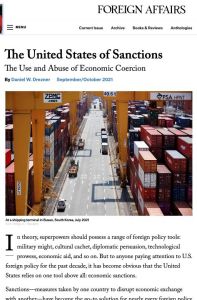Join getAbstract to access the summary!

Join getAbstract to access the summary!
Daniel W. Drezner
The United States of Sanctions
The Use and Abuse of Economic Coercion
Foreign Affairs, 2021
What's inside?
Economic sanctions have increasingly become the United States’ foreign policy tool of choice.
Recommendation
Professor Daniel W. Drezner claims that America’s use of economic sanctions as a means of enforcing its foreign policy agenda is falling flat. Coercive measures are essential tools of statecraft, but the United States needs to use those tools more wisely than more frequently, says Drezner, and it must articulate the conditions under which sanctions would be withdrawn as much as when they would be used. Students of political science and political economy will gain much from this sobering analysis.
Summary
About the Author
Daniel W. Drezner is a professor of international politics at the Fletcher School of Law and Diplomacy at Tufts University.




















Comment on this summary